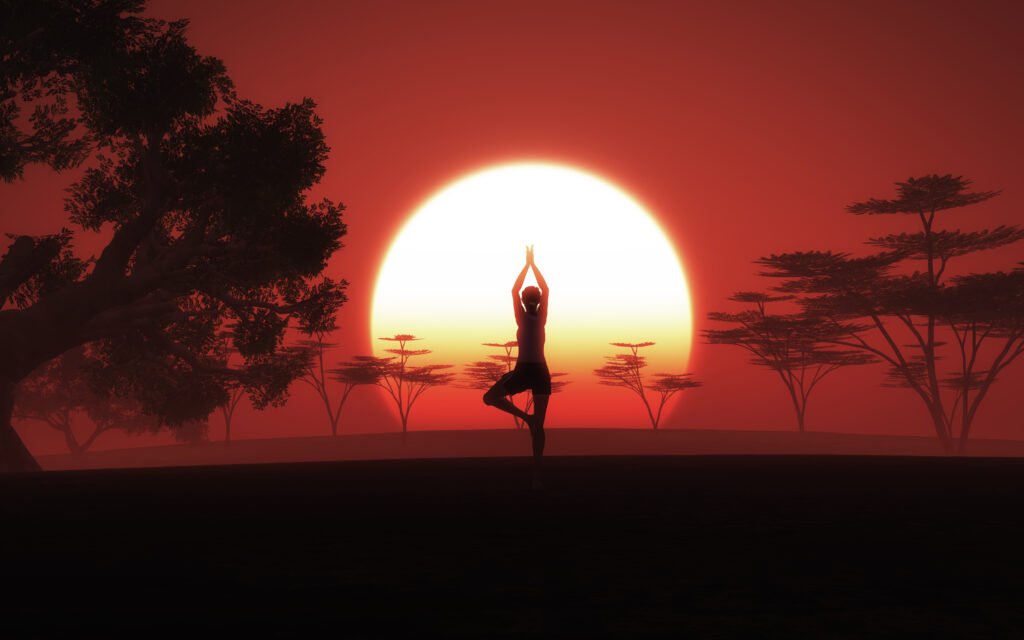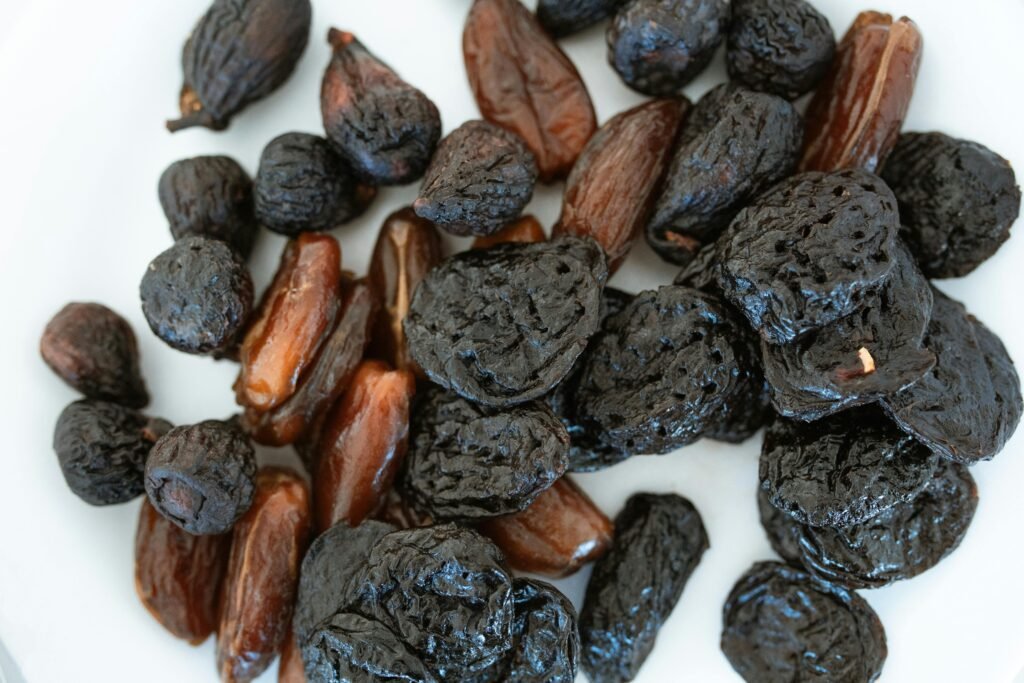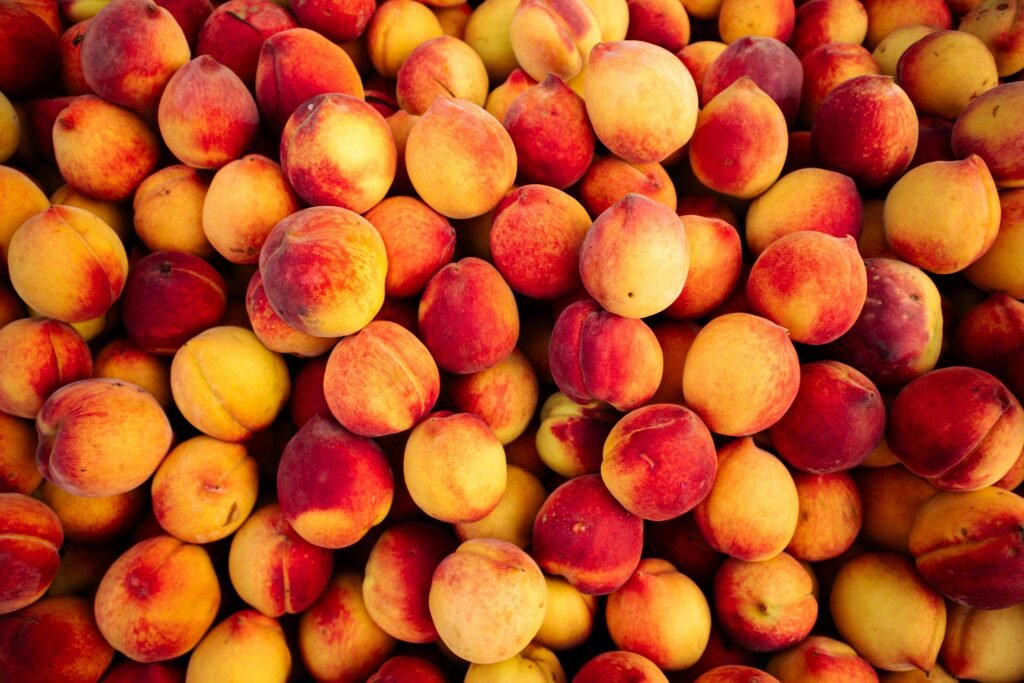Surya Namaskar is the Sanskrit name for a particular grouping of twelve yoga asana, also called a Sun Welcome. It is one of the most commonly realized yoga rehearses, integrated into a few distinct practices like Hatha, Vinyasa and Ashtanga. The term is gotten from two Sanskrit roots; surya, signifying “sun” and namaskar signifying “good tidings” or ‘greetings'”.Customarily, the act of Surya Namaskar was utilized for the purpose of offering appreciation to the sun. In Indian culture from which the training came, the sun is viewed as the wellspring of all life, and it is consequently critical.In Hinduism, Surya is the Lord of the sun, comprehended to be the maker of the universe, and in Vedic practice the sun is emblematic of awareness and the Heavenly. Thusly, Surya Namaskar is viewed as one of the main yoga rehearses.
steps:
1.Pranamasana (Petitioning heaven present)
Pranamasana or the Request Posture is the beginning posture for Surya Namaskara or the sun welcome posture. It denotes the start and end of a yoga practice. The advantages of Pranamasana incorporate reinforcing of the sensory system, and stance arrangement, and gives profound mending as well as a ceaseless progression of good energy and prana in the body. In this article, you can get familiar with the sorts of Pranamasana yoga, how to rehearse it consistently, its advantages, some fledgling tips, how frequently one should rehearse it, and precautionary measures to be taken while rehearsing this helpful posture.
Pranamasana yoga mudra is one of the most usually polished yoga mudras on the planet. The word Pranam Asana has its beginnings in the Sanskrit language, where Pranam signifies ‘to pay/give regard to somebody, and Asana is alluded to as a ‘present’. Pranamasana is otherwise called the request present on the grounds that, in this yoga mudra, one’s hands are kept intact in ‘Anjali mudra’ prominently known as namaskar.
stage:-
- Stand straight.
- Head east so you are facing the rising sun.
- Make sure your feet are close. Keep your knees straight.
- Breathe regularly. Exhale slowly.
- Cross your arms to join your palms at chest level, as if you are praying.
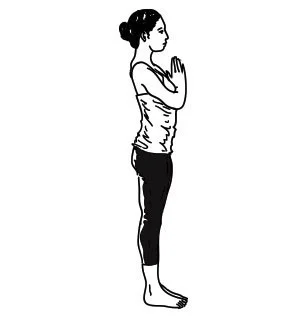
Benefits of Pranamasana :-
1. Loosens up the Brain and Soul :-
Pranamasana(Prayer Posture) advances total unwinding and internal harmony, like reflection. It helps calm the brain and lessen pressure and nervousness. Integrating this posture into your day to day schedule can give a quieting safe-haven in the midst of the mayhem of a bustling life.
2. Brings Mindfulness :-
In the present high speed world, care and body mindfulness can need. Pranamasana(Prayer Posture) upgrades mental mindfulness by assisting you with paying attention to your body’s necessities and answer actually. This training further develops thinking skills and keeps up with mental clearness significantly under tension.
3. Upgrades Body Stance :-
Reasonable for anybody who can stand straight, Pranamasana(Prayer Posture) further develops body pose. It cultivates certainty and upgrades non-verbal communication while likewise supporting the sensory system. The posture adjusts the spine, neck, and hips, advancing by and large skeletal wellbeing.
2. Hasta uttanasana (Raised arms present)
Hasta uttanasana is an asana that is a normal piece of the Surya Namaskar series. This specific posture is additionally utilized in yoga practice to heat up and reinforce the spine, as well as to open up the chest and heart to consider profound, full breaths. To perform hasta uttanasana, the yogi starts in tadasana. Then the two arms ascend above with palms meeting, shifting the head, neck, and chest area delicately in reverse while looking up at the thumbs.In Sanskrit, hasta alludes to the hands and uttana signifies “turning upwards.” While trying this represent, the spine is delicately bended with the look pointing upwards toward the lifted hands, empowering the heart and ribs to open up towards the roof, considering full breaths which increment oxygen stream.Hasta uttanasana is regularly rehearsed as the second and eleventh posture inside the Surya Namaskar successions that are in Hindu love of the sun powered divinity, Surya. In this asana, arms raise in salute to the sun, opening the heart to accepting its energy.
stage:-
- Inhale slowly.
- Raise your arms above your head and keep them straight.
- Gradually arch back.
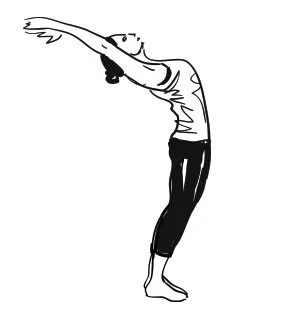
Benefits of Hasta Uttanasana:-
1.Extends, Fortifies, Stretches :-
Hasta Uttanasana, known for its extreme stretch upwards, assists with extending the front side of the body and reinforcing the back muscles. Specifically, it extends the muscles of the shoulders, neck, chest, midsection, psoas and reinforces hips, quads and knees. It is critical to be nonpartisan, as in Tadasana, keeping the internal thigh and quads locked in. Thus, this stance works on actual prosperity and brings the body once again into balance.
2. Mindfulness and Concentration :-
At the point when done in the correct manner, Hasta Uttanasana will fortify every one of the muscles in the body. This posture settles the knee joints and pelvis, making areas of strength for a. Understudies can feel the chest, midsection, and pelvis expanding assuming the arrangement is awesome. Understudies can zero in on the stance’s entirety by remembering all the arrangement without tossing the head back unnecessarily. They might feel an entire body twist by getting to the body’s center, holding regard for the mid-region. Notice the entire body pressure on the front side of the chest, mid-region, and thighs.
3. Arrangement and Stance :-
In Hasta Uttanasana, understudies begin to investigate the scope of the development in the spine. Strikingly, the cervical and thoracic spine (mid to upper spine). This posture is fundamental to advanced way of life. For instance, Working at a work area, housework, driving, and so on. Backbends, commonly, help to turn around the impacts of slouched pose and take the body back to the impartial position. Involving the right stance and keeping the spine in right arrangement are the main things to remember. Since the lower back bears the greater part of the weight, appropriate arrangement can forestall wounds to the vertebrae and circles.
3. Hasta padasana (Remaining forward twist)
Hasta padasana is a standing yoga present in which the expert roots one leg and, while adjusting, holds the other leg out before the body in a completely broadened position. The term is gotten from the Sanskrit hasta, signifying “hand,” pada, signifying “foot,” and asana, signifying “pose.”
This truly thorough posture requires an elevated degree of focus and pranayama, “breath control.”
Likewise with each posture in yoga, this position starts with, and is supported by, the breath. On the inward breath, the professional lays out center and unequivocally roots the supporting leg. On the exhalation, the non-attached leg starts to ease up. Toward the start of the accompanying inward breath, this leg rises and its knee goes to the chest. During mid-inward breath, the fingers of the hand relating to the lifted leg fold over the large toe and the leg is tenderly stretched out forward. Full inward breath tracks down the leg, with flexed toes, in its conclusive, broadened position; and the exhalation further establishing the supporting leg.
A further developed posture can be accomplished when the expert, in the wake of starting inward breath, tenderly moves the raised leg from the forward position out to the side of the body.
Hasta padasana has numerous profound advantages. As it reunites the front and back of the body, it stirs and synchronizes the breath and the brain. Each part of the specialist’s being is locked in and the outcome is a profound feeling of mindfulness and otherworldly harmony.
stage :-
- Exhale slowly.
- Bend forward from the waist, swinging your arms straight down.
- Let your palms touch the floor on either side of your feet.
- Keep your arms straight at the elbows.
- You should bend forward until your forehead touches your knees.

Benefits of Hasta padasana:-
1. Physical :-
It brings about outrageous extending of your back muscles.
It carries gracefulness to your spine.
Intra-stomach pressure gives great flow and back rub to your mid-region and pelvic viscera.
It conditions your stomach wall and decreases pointless fat stored in the stomach region. 5. It actuates clavicular breathing and helps legitimate ventilation of the highest piece of the lungs
2. Restorative :-
It usefully affects your back, hips and hamstring muscles.
It assists with invigorating the urogenital, stomach related, apprehensive and endocrine frameworks.
It supports blood dissemination to your head.
3.Mental :-
It further develops your psyche balance.
It gets a feeling of modesty and appreciation.
4. Ashwa Sanchalanasana (Equestrian posture)
Ashwa sanchalanasana is a low jump act with the chest lifted while the palms remain grounded on one or the other side of the front foot. The name comes from the Sanskrit words ashva, signifying “horse,” sanchalana, signifying “venturing development” (like a walk) and asana, signifying “seat.”Ashwa sanchalanasana is the fourth and ninth stance in Surya Namaskar. Expanding certainty, resolve and determination is accepted.Ashwa sanchalanasana gives a scope of actual advantages and is likewise viewed as an adjusting stance in light of the fact that the spine extends upwards while the hands are grounded. These restricting developments show the specialist adjusting inverse powers to make dependability. This example can likewise be applied to the harmony between the powers of mind/rationale and the more instinctive powers of nature.This stance ought to be polished with an emphasis on the ajna, or third eye, chakra. A mantra can likewise be recited without holding back or quietly during this stance. The relating mantras for ashwa sanchalanasana are “Aum Bhanave namah,” signifying “Welcome to Bhaanu, the sparkling one,” or the more limited bija mantra, “Om Hraym.”This pose is remembered to invigorate the anahata, manipura and svadisthana chakras.
stage:-
- Breathe in once more.
- Stretch your right leg in reverse till you are crouching over your left foot.
- Permit your right knee to lay on the floor.
- Keep your jaw raised.
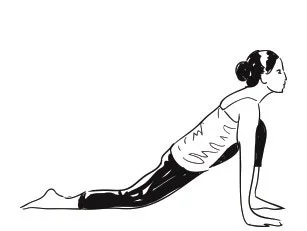
Benefits of Ashwa Sanchalanasana:-
Concentrates on show that low lurches are more viable than squats in connecting with the significant muscle gatherings of the lower body, and that the precariousness intrinsic in the position might enact and fortify underutilized muscles, giving you a more exhaustive exercise. Thusly, yoga professionals quality various actual advantages to this yoga present, including:
Extending the lower back, hip, and lower leg muscles
Opening the hip flexors and fortifying the hip extensors
Loosening up back muscles
Facilitating sciatica torment
Connecting profound center muscles
Further developing equilibrium and making security
Preparing your body to do profound backbends
Developing lower-body fortitude, especially in the legs, lower legs, feet, knees, and hips
Fortifying the quadriceps, hamstring, gluteus maximus, and psoas muscles
Further developing lung limit
A huge number likewise accept that ashwa sanchalanasana invigorates the anahata, manipura, and svadisthana chakras, assisting people with creating certainty, assurance, balance, and resolve. The posture may likewise help the stomach organs and decrease acid reflux.
The equestrian posture fills in as a compelling warm-up stretch for sprinters and different competitors. It might likewise assist with delivering nervousness and stress, causing you to feel more invigorated by and large.
5.Dandasana (Stick pose)
Dandasana is a basic situated act with the legs straight before the body and the spine upstanding and long. The name comes from the Sanskrit danda which signifies “stick” or “staff” and asana which signifies “stance” or “seat.”It is a stance which requires a lot of mindfulness and presence to hold and, in that capacity, is viewed as great for turning out to be more careful and centered in one’s yoga practice. It likewise readies the body and brain for other situated stances.Dandasana is purported on the grounds that the spine looks like the staff conveyed by Indian renunciates who have accomplished the title of master danda. The actual staff is said to address the spinal segment and the manner in which it shapes the way for the energy of self-arousing. Dandasana is, in this way, viewed as the best asana for advancing strength and great structure, which upholds one’s profound excursion.As well as supporting the right progression of energy in the body, this posture is viewed as really great for assisting one with interfacing with the three bandhas, or “seals” or “locks.” By at the same time drawing in mula bandha, uddiyana bandha and jalandhara bandha in dandasana, you make maha bandha, or the “extraordinary lock,” which extends the experience and consciousness of the entire stance.Dandasana is the main situated pose in the Ashtanga yoga essential series and, in that capacity, frames the establishment for any remaining situated stances. Further developed varieties of dandasana incorporate ubhaya padangusthasana and utpluti dandasana.
stage:-
- Pause your breathing.
- Allow your arms to bear the heaviness of your body and gradually stretch your left leg in reverse.
- Presently, your body should shape a board.
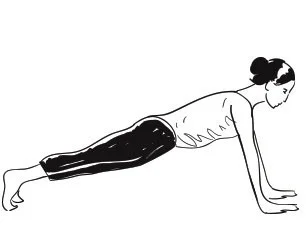
Benefits of Dandasana :-
1. Oversees pressure :-
Rehearsing Dandasana can assist you with overseeing pressure. It works on your psychological well-being, mindfulness and profound equilibrium. It assists in quieting your brain and handling issues with enjoying nervousness and despondency.
2. Works on your stance :-
Dandasana is advantageous assuming you experience the ill effects of postural issues because of your inactive way of life. Routinely rehearsing the posture can fix your spine and further develop your general stance when you sit, stand or walk.
3. Helps your respiratory framework:-
Dandasana is additionally a magnificent method for improving your breathing limit. Rehearsing the posture routinely can assist with relieving respiratory issues like asthma and windedness.
4. Directs your pulse :-
As indicated by a review, Dandasana can likewise assist with bringing down your pulse. Be that as it may, further examinations are to be directed to know the adequacy of the asana in overseeing hypertension.
6. Ashtanga Namaskara (Salute with eight sections or focuses)
Ashtanga namaskara is a stance where the body is adjusted on eight resources with the floor: feet, knees, chest, jaw and hands. It frames part of the old style Surya Namaskar succession and is likewise utilized as an option to chaturanga dandasana.
The name comes from the Sanskrit words, ashta, signifying “eight,” anga, signifying “part” or “appendage,” and namaskara, signifying “bowing” or “hello.” Ashtanga namaskara may likewise be referred to in English as knee-chest-jaw present.
The motion in this asana of bringing the body down to contact the floor is viewed as a salute or giving proper respect. It is frequently performed by fans to offer appreciation to the divine beings while visiting sanctuaries in India.
It is said that center ought to be coordinated to the manipura chakra as the chest contacts the floor in this stance. At the point when performed during Surya Namaskara, the mantra, Aum Pooshne namah can be recited, and that signifies “Greetings to Pushan, the spiritualist fire,” or “Welcome to the person who invigorates.” another option, more limited bija mantra can be utilized during more quick practice, which is Om Hrah.
stage:-
- Take out.
- Bend your legs so that your knees touch the floor.
- Lower your chest until it touches the floor.
- Make sure your stomach and hips are still up.
- Leave your forehead on the ground.

Benefits of ashtanga namaskara :-
1. Further develops Adaptability and Stance:-
Ashtanga Namaskara challenges the muscles around the spine, expanding adaptability and strength. This stance improves the normal arrangement of the spine and can lighten back torment.
2. Cleanses the Body and Brain :-
This posture plans to scrub and clean from the back to front. By zeroing in on care and eliminating inward mess, you accomplish a better body, a quiet brain, and expanded energy.
3. Fortifies and Stretches Muscles :-
This posture extends the soles, toes, lower back, hips, and neck while fortifying the mid-region, center, knees, and chest. Legitimate breathing (pranayama) during the posture additionally helps in pressure decrease.
4. Advances a Better Way of life :-
As a preliminary posture for further developed rehearses, Ashtanga Namaskara increments blood stream, tones muscles, and constructs certainty. It upholds an all encompassing way to deal with health.
7. Bhujangasana (Cobra pose)
The Bhujangasana importance returns to old times. ‘Bhujang’ is perceived as ‘cobra’ in Sanskrit, the word ‘asana’ signifies ‘act’. This yoga pose, which is a piece of the Surya Namaskar, can help your wellbeing.Bhujangasana is a delicate backbend yoga represent that is delegated hatha yoga. It is likewise an option in contrast to Urdhva Mukha Svanasana in the Surya Namaskar cycle.Known by another name, Cobra Posture, it was initially shown in the seventeenth century Gheranda Samhita, from that point forward, the principal motivation behind this yoga has been to keep you empowered and moving over the course of the day.
stage:-
- suck her
- Lift your head off the floor.
- Pull your body forward and up, arching your back. You should look like a cobra ready to strike.
- Leave your elbows bent, but keep your palms firmly on the floor.
- Your body should rest on the floor from the hips down.
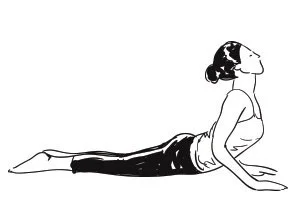
Benefits of Bhujangasana:-
1. Builds the arm power:-
As yoga is finished with the strength of hands, it hardens your shoulders, biceps, and rear arm muscles.
2. Expanded adaptability :-
The snake present stretches all aspects of the body, prompting expanded adaptability.
3.Assuages sciatic nerve torment:-
Bhujangasana facilitates sciatic torment for moderately aged people. It decreases the muscle strain in the impacted leg by extending.
4. Lessens the impacts of asthma:-
The snake present clears the breathing line when you take full breaths. It builds your lung limit, lightening respiratory issues or asthma’s belongings.
5. Benefits various region of your body :-
The midsection, spine, posterior, arms, and chest are the principal regions profiting from this yoga present. Any uneasiness in these body parts gets help.
8. Adho Mukha Svanasana (Descending confronting canine posture)
Adho Mukha Svanasana, otherwise called Descending Confronting Canine Posture, is a generally perceived and famous yoga act. While doing the represent the body gets extended, making it valuable for further developing adaptability and equilibrium. Adho Mukha Svanasana is a simple yoga represent that can be learnt in couple of practices just, but appropriate arrangement and commitment of muscles is must. Rehearsing this posture can assist with developing full-body fortitude and increment in general adaptability.
Adho Mukha Svanasana, otherwise called Descending Confronting Canine Posture, is a yoga act that gets its name from the old Indian language Sanskrit. In Sanskrit, “adho” signifies “descending, ” “mukha” signifies “face, ” and “svana” signifies “canine. ” This name impeccably portrays the place of the body here, looking like a canine extending and unwinding, with the face pointed downwards.
stage:-
- Breathe out.
- Raise your hips while holding your head down, between your arms.
- Your middle ought to move in reverse and upwards while your arms and feet are put immovably on the floor.
- Your body is looking like an altered “V” presently.
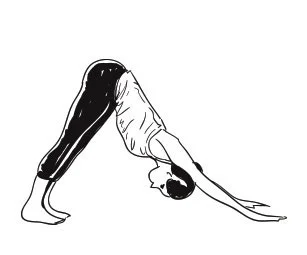
Benefits of Adho Mukha Svanasana:-
1. Adaptability and Scope of Movement :-
This posture opens the upper back and mid-back muscles. The arms and legs are extended, and this builds nimbleness and scope of movement. The lower leg muscles, Achilles ligament, and the tendons appended to the lower leg joints are extended, improving joint portability. The knee joint is fortified with dynamic lower legs and calves. Upgraded joint portability with strong versatility increments body adaptability.
2.Mindfulness and Concentration (Fixation) :-
Adho Mukha Svanasana (Descending Confronting Canine Posture) is a difficult posture as need might arise to keep a level back in the reversal. To push the heels to the floor, there is a propensity to push the bottom down and make a hunch toward the back. Subsequently, understudies ought to be directed and made to comprehend that the objective isn’t to contact the heel to the floor however to make a foremost pelvic slant by guiding the backside toward the roof. This arrangement opens the hamstring and glutes. The course of the heel contacting the floor occurs over predictable practice. At the point when Uddiyana Bandha (Up Stomach Lock Close Up) is likewise practice with Descending Confronting Canine Posture, it makes center strength, supporting the whole back, shoulders, and legs to stay stable during the stance.
3. Arrangement and Stance :-
While the understudy develops the posture in an Angular shape, the shoulder bones open, and the middle extends. There is a hip opening with the rump highlighted the roof and a profound stretch at the glutes. It makes a spinal expansion from the lumbar to the cervical, conditioning the spine. These arrangements with conditioned arms and legs make a sure and solid body act.
4. Excitement and Organs :-
The reversal in the posture increments blood dissemination to the tactile organs, heart, and mind. The Uddiyana Bandha animates the stomach related organs.
9. Ashwa Sanchalanasana (Equestrian posture)
Ashwa sanchalanasana is a low jump act with the chest lifted while the palms remain grounded on one or the other side of the front foot. The name comes from the Sanskrit words ashva, signifying “horse,” sanchalana, signifying “venturing development” (like a walk) and asana, signifying “seat.”Ashwa sanchalanasana is the fourth and ninth stance in Surya Namaskar. Expanding certainty, resolve and determination is accepted.Ashwa sanchalanasana gives a scope of actual advantages and is likewise viewed as an adjusting stance in light of the fact that the spine extends upwards while the hands are grounded. These restricting developments show the specialist adjusting inverse powers to make dependability. This example can likewise be applied to the harmony between the powers of mind/rationale and the more instinctive powers of nature.This stance ought to be polished with an emphasis on the ajna, or third eye, chakra. A mantra can likewise be recited without holding back or quietly during this stance. The relating mantras for ashwa sanchalanasana are “Aum Bhanave namah,” signifying “Welcome to Bhaanu, the sparkling one,” or the more limited bija mantra, “Om Hraym.”This pose is remembered to invigorate the anahata, manipura and svadisthana chakras.
stage:-
- Breathe in.
- Present your right leg with the goal that your right ottomans between your hands.
- Lift your head up all the while.
- Notice that this position is like the fourth.

Benefits of Ashwa Sanchalanasana:-
Concentrates on show that low lurches are more viable than squats in connecting with the significant muscle gatherings of the lower body, and that the precariousness intrinsic in the position might enact and fortify underutilized muscles, giving you a more exhaustive exercise. Thusly, yoga professionals quality various actual advantages to this yoga present, including:
- Extending the lower back, hip, and lower leg muscles
- Opening the hip flexors and fortifying the hip extensors
- Loosening up back muscles
- Facilitating sciatica torment
- Connecting profound center muscles
- Further developing equilibrium and making security
- Preparing your body to do profound backbends
- Developing lower-body fortitude, especially in the legs, lower legs, feet, knees, and hips
- Fortifying the quadriceps, hamstring, gluteus maximus, and psoas muscles
- Further developing lung limit
A huge number likewise accept that ashwa sanchalanasana invigorates the anahata, manipura, and svadisthana chakras, assisting people with creating certainty, assurance, balance, and resolve. The posture may likewise help the stomach organs and decrease acid reflux.
The equestrian posture fills in as a compelling warm-up stretch for sprinters and different competitors. It might likewise assist with delivering nervousness and stress, causing you to feel more invigorated by and large.
10. Hasta padasana (Remaining forward twist)
Hasta padasana is a standing yoga present in which the expert roots one leg and, while adjusting, holds the other leg out before the body in a completely broadened position. The term is gotten from the Sanskrit hasta, signifying “hand,” pada, signifying “foot,” and asana, signifying “pose.”This truly thorough posture requires an elevated degree of focus and pranayama, “breath control.”
Likewise with each posture in yoga, this position starts with, and is supported by, the breath. On the inward breath, the professional lays out center and unequivocally roots the supporting leg. On the exhalation, the non-attached leg starts to ease up. Toward the start of the accompanying inward breath, this leg rises and its knee goes to the chest. During mid-inward breath, the fingers of the hand relating to the lifted leg fold over the large toe and the leg is tenderly stretched out forward. Full inward breath tracks down the leg, with flexed toes, in its conclusive, broadened position; and the exhalation further establishing the supporting leg.
A further developed posture can be accomplished when the expert, in the wake of starting inward breath, tenderly moves the raised leg from the forward position out to the side of the body.Hasta padasana has numerous profound advantages. As it reunites the front and back of the body, it stirs and synchronizes the breath and the brain. Each part of the specialist’s being is locked in and the outcome is a profound feeling of mindfulness and otherworldly harmony.
stage:-
- Breathe out.
- Present your left leg with the goal that your left foot also rests between your hands.
- All the while, contact your knees with your temple.
- Guarantee that your neck is loose.
- Notice that this stance is like the third position.
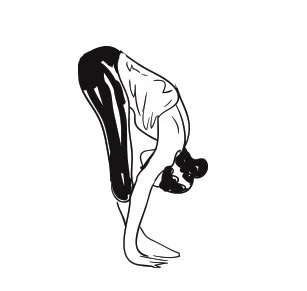
Benefits of Hasta padasana :-
1. Physical :-
. It brings about outrageous extending of your back muscles.
. It carries gracefulness to your spine.
. Intra-stomach pressure gives great flow and back rub to your mid-region and pelvic viscera.
. It conditions your stomach wall and decreases pointless fat stored in the stomach region.
. It actuates clavicular breathing and helps legitimate ventilation of the highest piece of the lungs.
2. Restorative :-
. It usefully affects your back, hips and hamstring muscles.
. It assists with invigorating the urogenital, stomach related, apprehensive and endocrine frameworks.
. It supports blood dissemination to your head.
3. Mental:-
. It further develops your psyche balance.
. It gets a feeling of modesty and appreciation
11. Hasta uttanasana (Raised arms present)
Hasta uttanasana is an asana that is a normal piece of the Surya Namaskar series. This specific posture is additionally utilized in yoga practice to heat up and reinforce the spine, as well as to open up the chest and heart to consider profound, full breaths.
To perform hasta uttanasana, the yogi starts in tadasana. Then the two arms ascend above with palms meeting, shifting the head, neck, and chest area delicately in reverse while looking up at the thumbs.In Sanskrit, hasta alludes to the hands and uttana signifies “turning upwards.” While trying this represent, the spine is delicately bended with the look pointing upwards toward the lifted hands, empowering the heart and ribs to open up towards the roof, considering full breaths which increment oxygen stream.Hasta uttanasana is regularly rehearsed as the second and eleventh posture inside the Surya Namaskar successions that are in Hindu love of the sun powered divinity, Surya. In this asana, arms raise in salute to the sun, opening the heart to accepting its energy.
stage :-
- Breathe in.
- Fix your body gradually.
- Keep your arms outstretched so they are stuck between a rock and a hard place now with your fingers pointing upwards.
- Gradually twist in reverse in a delicate curve and let your arms twist as well.
- Notice that this stance is like the subsequent position.
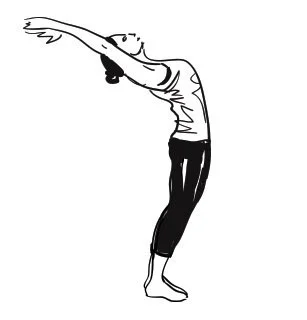
Benefits of Hasta uttanasana:-
1.Extends, Fortifies, stretches :-
Hasta Uttanasana, known for its extreme stretch upwards, assists with extending the front side of the body and reinforcing the back muscles. Specifically, it extends the muscles of the shoulders, neck, chest, midsection, psoas and reinforces hips, quads and knees. It is critical to be nonpartisan, as in Tadasana, keeping the internal thigh and quads locked in. Thus, this stance works on actual prosperity and brings the body once again into balance.
2. Mindfulness and Concentration:-
At the point when done in the correct manner, Hasta Uttanasana will fortify every one of the muscles in the body. This posture settles the knee joints and pelvis, making areas of strength for a. Understudies can feel the chest, midsection, and pelvis expanding assuming the arrangement is awesome. Understudies can zero in on the stance’s entirety by remembering all the arrangement without tossing the head back unnecessarily. They might feel an entire body twist by getting to the body’s center, holding regard for the mid-region. Notice the entire body pressure on the front side of the chest, mid-region, and thighs.
3. Arrangement and Stance:-
In Hasta Uttanasana, understudies begin to investigate the scope of the development in the spine. Strikingly, the cervical and thoracic spine (mid to upper spine). This posture is fundamental to advanced way of life. For instance, Working at a work area, housework, driving, and so on. Backbends, commonly, help to turn around the impacts of slouched pose and take the body back to the impartial position. Involving the right stance and keeping the spine in right arrangement are the main things to remember. Since the lower back bears the greater part of the weight, appropriate arrangement can forestall wounds to the vertebrae and circles.
12. Tadasana (Mountain Posture)
Tadasana is the Sanskrit name for a central yoga asana, also called Mountain Posture. Being the outline that shapes the premise of any remaining standing postures is thought of. Tadasana is the beginning and completing place of all Sun Greeting successions, notwithstanding its utilization as a resting present between other more demanding stances. The term is gotten from two Sanskrit roots; tada, signifying “mountain” and asana signifying “seat” or “stance.”
Regardless of appearing to be no unique from basically standing, tadasana is a functioning posture, where the specialist takes part in cognizant consciousness of muscle enactment and stance.
Tadasana is both genuinely and intellectually establishing and can be utilized for the purpose of advancing security in body and brain. In assisting the expert to frame an association with the earth, tadasana is accepted to animate the root chakra, emblematic of a feeling of safety, security and rootedness. The stance conjures samasthiti, a term signifying “equivalent or consistent position,” and which is at times utilized reciprocally with tadasana.Generally, the drishti (looking point) for tadasana is at the tip of the nose, also called nasagra drishti. While this can assist with creating fixation, a few schools of yoga favor a looking point straight ahead to keep up with equilibrium, or even propose shutting the eyes for the purpose of drawing the mindfulness internal.
A further developed variant of tadasana includes connecting each of the three bandhas (vivacious locks); mula bandha (root lock), uddiyana bandha (stomach lock) and jalandhara bandha (throat or jaw lock).Tadasana assists with developing quietness, strength and a feeling of strengthening, representative of its namesake. Generally, it is drilled between any remaining standing postures, for of permitting the brain and body to incorporate the advantages of the past asana while getting ready for the following one.
stage:-
- Breathe out leisurely.
- Fix your middle and arms back up till you are standing erect.
- Bring down your arms till your fingers point downwards.
- Permit your body to unwind.
- Notice that you have now returned to the principal position.
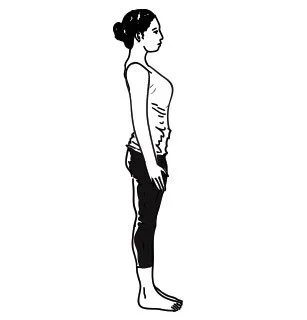
Benefits of Tadasana:-
1. Upgrades Your Stance :-
Rehearsing the Mountain Posture can be of extraordinary assistance to individuals who have the impulse to hunch or slump while strolling or sitting. On playing out this asana routinely, the back aggravation because of the slouched pose slowly vanishes which at long last works on the general stance and assists an individual with normally standing tall.
2. Help with Expanding Level :-
A decent level generally has an additional advantage to one’s character. Individuals who have an inclined feeling of dread toward achieving a more limited level can begin rehearsing this asana in their young years to add a couple of extra crawls to their level. The extension or stretch while doing the asana actuates pose pressure which thus supports the development of development chemical that aides in extending all pieces of the body.
Benefits Of Surya Namaskar:-
1. Deals with a Solid Weight :-
Since surya namaskar draws in various muscles of the body and helps consume calories, it is a very compelling activity for dealing with a sound weight. You can likewise saddle the surya namaskar benefits for weight reduction with normal practice and cultivate a better digestion.
2. Further develops Blood Flow :-
One more benefit of surya namaskar is that it advances a musical progression of breath that likewise improves blood dissemination. This is on the grounds that it conveys oxygen and supplements to cells while helping waste evacuation.
3. Makes Your Skin Shine :-
Assuming you wish to get splendid and gleaming skin, begin doing surya namaskar consistently. Why? This is on the grounds that this exercise incites a characteristic sparkle by advancing blood dissemination and detoxification. In this way, begin your day with surya namaskar and get solid and brilliant skin.
4. Gives Mental Lucidity and Unwinding :-
Did you know surya namaskar is an activity that advances mind-body health? It enjoys actual benefits as well as diminishes pressure and advances mental lucidity. The blend of breathwork and actual development upgrades your general prosperity and prompts a condition of unwinding.
5. It Balances Hormones :-
Sun exposure can also help balance hormones and improve your overall hormonal health. Indeed, the conscious synchronization of breath and movement supports endocrine function and contributes to hormonal balance.
6. Reinforces Muscles and Joints :-
Sun greeting benefits by focusing on different muscle gatherings, advancing strength and adaptability in the arms, legs, center, and back. This superior strength means better stance and backing for your joints over the course of the day.
7. Further Develops Concentration and Fixation :-
The careful breathing activities integrated into Surya Namaskar can assist with quieting the psyche and further develop center. This can be helpful for understudies, experts, or anybody who requirements to think over the course of the day.
8.It Increases the heart rate:-
Finally, another benefit of practicing surya namaskar is that it increases the heart rate and provides a complete cardiovascular workout that helps strengthen the heart and build endurance. Start practicing surya namaskar daily and improve your heart health and general physical condition

